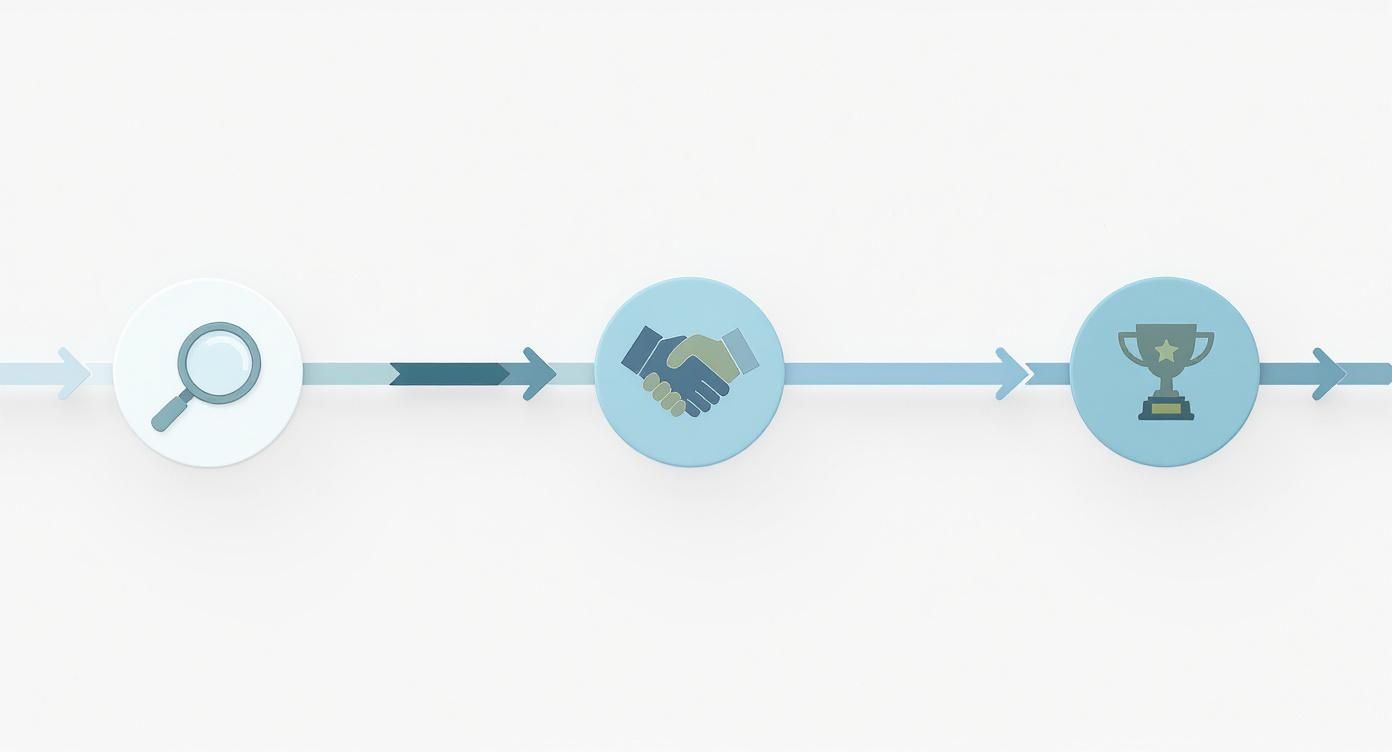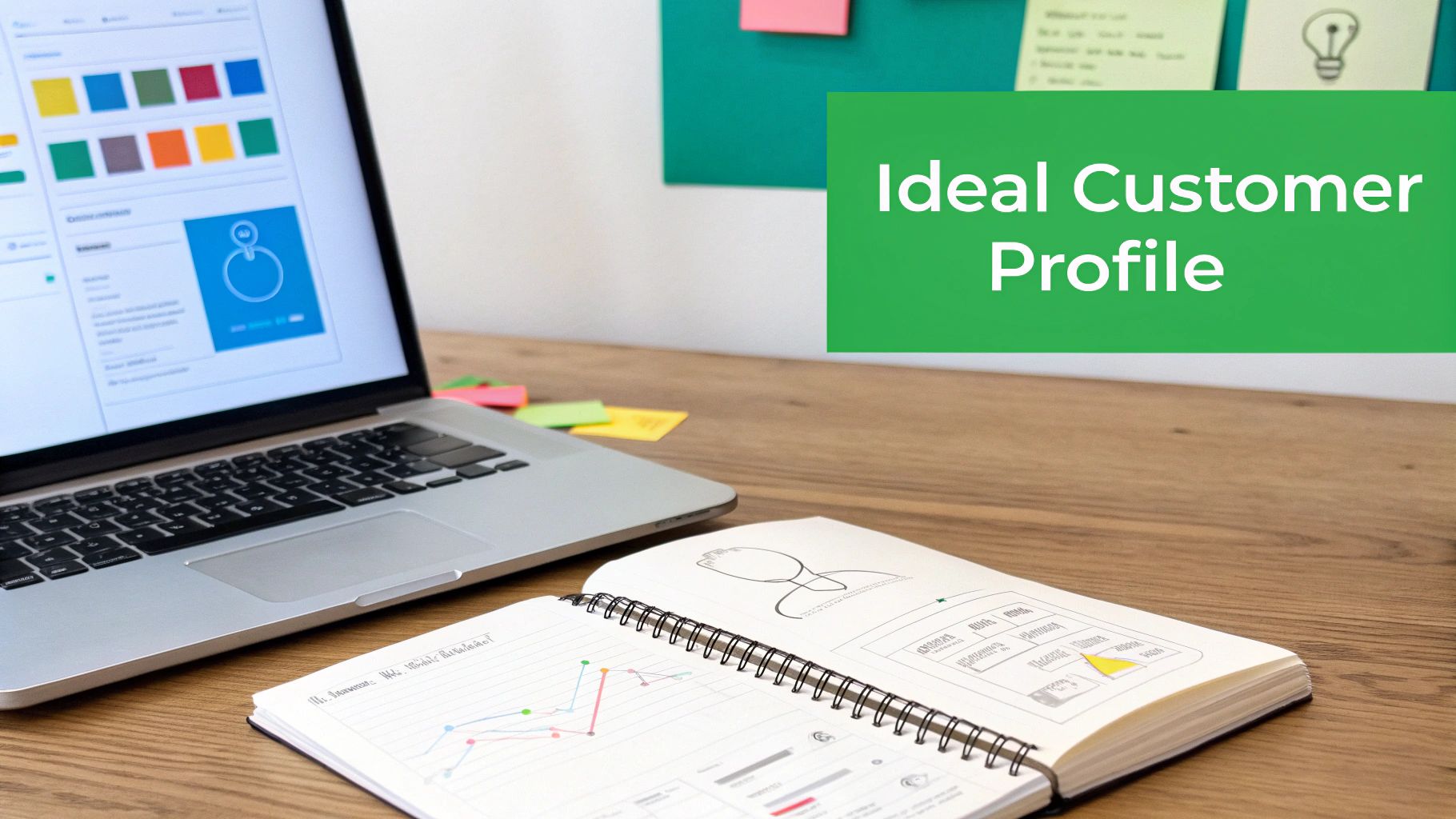how to build sales pipeline that converts
Forget the old playbook of just stuffing names into a funnel. Building a sales pipeline that actually works today means creating a system that mirrors how modern buyers really make decisions. It's about precision—defining your ideal customer, mapping out clear stages, and getting your digital prospecting and qualification process dialed in.
Your Blueprint for a Modern Sales Pipeline
Let's move past the high-volume, low-quality outreach that just doesn't cut it anymore. A high-converting pipeline is a living, breathing process, not some static list of contacts. To get this right, you first need a solid understanding of sales pipeline management. This guide is all about ditching outdated tactics for a smarter approach that respects your buyer's time and intelligence.
The whole game has shifted online. The core idea now is to align every single sales activity with the digital buyer's journey. This isn't optional—a staggering 80% of B2B sales interactions now happen in digital channels. That’s a massive jump from just 20% a decade ago.
A modern approach really boils down to three key things:
- Targeted Prospecting: Finding leads who are already out there looking for solutions.
- Value-Driven Engagement: Building trust by being genuinely helpful at every touchpoint.
- Data-Informed Optimization: Using real numbers to constantly tweak and improve your process.
The infographic below gives a clean visual of how a modern pipeline flows, from that first point of contact to closing the deal.

As you can see, each stage—prospecting, engagement, and closing—demands its own unique set of actions and goals. Nailing this flow is the bedrock of building a pipeline that delivers predictable, consistent revenue.
Key Sales Pipeline Stages and Their Purpose
To help clarify, here's a quick breakdown of the essential stages in a typical sales pipeline. Think of this as your roadmap from "who are they?" to "welcome aboard."
| Pipeline Stage | Primary Goal | Key Activity Example |
|---|---|---|
| Prospecting | Identify potential good-fit customers who match your ideal profile. | Using AI tools to find companies actively discussing a problem you solve. |
| Qualification | Determine if a prospect has the need, budget, and authority to buy. | A 15-minute discovery call to understand their main challenges and timeline. |
| Meeting/Demo | Showcase your solution and how it directly solves their specific problem. | A personalized product demonstration focused on their unique use case. |
| Proposal | Present a formal offer outlining scope, pricing, and terms. | Sending a detailed proposal that summarizes the value and ROI discussed. |
| Closing | Finalize the agreement and get the contract signed. | Negotiating terms and handling any final questions before they sign. |
Mastering these distinct phases is what separates a pipeline that just exists from one that actively drives growth.
Before you even think about adding a single lead to your pipeline, you need a clear map. You have to know exactly who you're targeting and what their journey with you will look like. The first step in building a sales pipeline that actually works is getting serious about your Ideal Customer Profile (ICP). This goes way deeper than just company size and industry.
A solid ICP breaks down the mindset of your best customers. What are their biggest headaches? What specific triggers make them search for a solution right now? For example, a software company might discover their ICP isn't just "mid-size tech companies." It's more like, "Series B tech companies where engineers are complaining about clunky workflow tools on Reddit." That level of detail is a game-changer.
Map Your Pipeline to the Buyer Journey
Once you know who you're talking to, you can design pipeline stages that reflect how you actually sell, not some generic template. Vague labels like "Interested" or "Contacted" are completely useless for forecasting. You need actionable milestones that show real progress.
A well-structured pipeline tells a story. Each stage should be a chapter that clearly answers the question, "What did we accomplish to move this deal forward?" This clarity is the foundation of predictable revenue.
Think in terms of concrete achievements. What must happen before a deal can move to the next stage? This approach turns your pipeline from a simple to-do list into a strategic tool for spotting bottlenecks before they wreck your forecast.
Here are a few examples of meaningful, action-based stages:
- Lead Qualified: The prospect fits your ICP and has confirmed they're dealing with a relevant problem.
- Discovery Call Completed: You’ve had a structured conversation to uncover their budget, authority, need, and timeline (BANT).
- Solution Demo Delivered: You’ve shown them a personalized demo that directly addresses the challenges discussed during discovery.
- Proposal Under Review: A formal proposal is in the hands of the key decision-makers.
- Negotiation: You're actively discussing terms, pricing, or contract details.
This kind of structure gives you an honest, real-time picture of your sales health. You'll know exactly where deals are getting stuck, which means you can step in before your entire quarter goes off the rails. It’s the essential groundwork for building a pipeline that consistently delivers.
Master Prospecting in a Digital-First World
The old playbook of relentless cold calling is officially dead. If you want to build a modern sales pipeline, you have to get good at finding high-quality leads in a world where buyers educate themselves long before they ever talk to a salesperson. This means you need a multi-channel strategy that’s all about precision and relevance.
A winning approach today mixes social selling on platforms like LinkedIn with the smart use of tools that can spot powerful buying signals. The whole idea is to move away from the old "spray and pray" method to a highly targeted one that sparks genuine interest from the very beginning. This is how you turn a cold outreach into a warm, relevant conversation that people actually want to have.

This focus on quality over quantity is absolutely critical. The biggest wall sellers are running into today is that buyers just don't want to engage—a whopping 55.4% say it's their top challenge. On top of that, 46.5% of sellers feel bogged down by too many manual tasks. The full state of pipeline generation report breaks down even more of these hurdles.
Pinpoint High-Intent Leads
Instead of just guessing who might be interested, you can now use technology to find companies that are actively looking for the kind of solution you offer. This is a core part of building a sales pipeline that actually performs month after month.
For instance, a tool like Intently.ai can monitor online communities and discussions to flag prospects who are:
- Asking for recommendations for software in your exact category.
- Complaining about a competitor’s product and actively looking for a switch.
- Talking about a business problem that your solution is built to solve.
This lets your team jump into the conversation at the perfect moment with a message that’s helpful, not pushy. You can get a much deeper look at these methods in our guide on how to generate leads with AI.
By focusing on intent, you're not just finding leads; you're finding active buyers. You're meeting them exactly where they are, with the information they need, turning prospecting into problem-solving.
This proactive, insight-driven method makes sure the leads coming into the top of your pipeline are already warm and way more likely to convert. To really fill your sales pipeline effectively, you need to explore proven strategies for acquiring new prospects and mastering Lead Generation Best Practices. It’s simply the most efficient way to build momentum from day one.
Put a Rigorous Lead Qualification Process in Place
A pipeline jam-packed with unqualified leads is a fast track to wasted effort and missed quotas. Seriously. The secret to a high-performing sales pipeline is discipline—making sure your team only invests time in opportunities that have a real shot at closing. This isn't just about collecting contacts; it's about asking the tough questions early on to make sure you're heading in the right direction.
This means you’ll want to adapt classic methodologies for today's sales conversations. Frameworks like BANT (Budget, Authority, Need, Timeline) and MEDDIC are a solid foundation for your discovery calls. The goal isn’t to mechanically run through a checklist, but to have a natural conversation that uncovers genuine business pain points and potential roadblocks.

This kind of discipline is exactly what keeps your pipeline healthy and your sales forecasts reliable. A strong qualification process is just as critical as generating the leads in the first place. For a much deeper dive into this, check out our complete guide on how to qualify sales leads.
Asking the Right Discovery Questions
Your first calls should feel more like a consultation than an interrogation. Instead of just confirming they have a budget, dig in and find out how that budget was even decided on.
Some effective qualification questions I’ve seen work well include:
- To Uncover Need: "What's the primary challenge you're hoping to solve, and what happens if you don't solve it in the next six months?"
- To Confirm Authority: "Besides yourself, who else on the team will be involved in evaluating this solution?"
- To Gauge Timeline: "What internal deadlines or events are driving the need to have a solution in place by a certain date?"
The point of qualification isn't just to see if they can buy; it's to determine if you should sell to them. A bad-fit customer will drain your resources and eventually churn, which makes disqualifying early a huge strategic advantage.
Identifying Red Flags Early
Pay close attention to signs that a deal might not be a good fit. Vague answers about the budget, an inability to connect you with other stakeholders, or a general lack of urgency are all major red flags.
By spotting these issues upfront, you prevent unqualified leads from eating up valuable time and skewing your pipeline data. This frees up your team to focus exclusively on the deals with the highest potential to close.
Nurture and Advance Opportunities Through the Pipeline
So you’ve got a qualified lead in your pipeline. That's a great start, but it's really just the starting line. The true art of building a sales pipeline that actually closes deals is in how you guide those opportunities from one stage to the next—without sounding like a pushy robot.
This is where smart nurturing comes into play.
The modern buyer's journey is anything but a straight path. It now takes an average of more than eight touchpoints to close a deal. Yet, a staggering 44% of salespeople throw in the towel after just one follow-up. That isn’t a lack of effort; it’s a broken process. Real nurturing is about building trust and proving your value over time.
Mix Your Touchpoints for Maximum Impact
If you’re only relying on one channel, like email, you’re setting yourself up to be ignored. The right move is to use a thoughtful blend of high-tech and high-touch interactions.
- Valuable Content: Share a case study or blog post that hits on a pain point they brought up during your discovery call. It shows you were actually listening.
- Personalized Video: Use a tool like Loom to record a quick, informal video checking in or explaining something complex. A personal touch like this cuts through the noise of a packed inbox.
- Strategic Insights: Offer up something genuinely useful with no strings attached. Think a quick competitor analysis or an interesting industry report they might have missed.
The point of nurturing isn't just to keep asking for the sale. It’s to position yourself as a trusted advisor, making your solution the clear choice when they’re finally ready to pull the trigger.
This kind of multi-channel approach keeps the conversation alive and stops opportunities from going cold just because you failed to engage in a meaningful way. It's all about making every single prospect feel understood throughout their entire journey.
Measure, Analyze, and Optimize Your Pipeline Performance

Here's a hard truth: a sales pipeline isn't a "set it and forget it" tool. It’s a living system that needs constant attention to perform at its peak. Building your pipeline is really just the starting line—the real growth comes from continuously measuring, analyzing, and fine-tuning its performance.
This data-driven approach is what separates good sales teams from the truly great ones. Without tracking the right metrics, you’re essentially flying blind. You might feel busy, but you won't know if your efforts are actually moving the needle. The goal is to turn all that raw data into insights you can actually use to drive predictable revenue.
Key Pipeline Metrics to Monitor
So, where do you start? Don't try to track everything at once. Begin by focusing on a handful of high-impact KPIs that give you a clear, honest picture of your pipeline's health. These numbers tell a story about where deals are flowing smoothly and, more importantly, where they’re getting stuck.
To understand how healthy and efficient your pipeline is, you need to keep a close eye on a few key performance indicators. This table breaks down the most important ones.
Essential Sales Pipeline Metrics to Track
| Metric | What It Measures | Why It's Important |
|---|---|---|
| Pipeline Velocity | The speed at which deals move through your pipeline and convert to revenue. | This is the ultimate health score for your sales process. A higher velocity means a shorter sales cycle and faster revenue generation. |
| Stage-by-Stage Conversion Rates | The percentage of deals that successfully advance from one stage to the next. | This metric is your secret weapon for finding bottlenecks. It shows you exactly where in your process deals are stalling or falling through. |
| Average Deal Size | The average value of a closed-won deal over a specific period. | Knowing this number is critical for accurate revenue forecasting and helps you identify which types of leads are the most valuable to your business. |
| Sales Cycle Length | The average time it takes for a lead to become a paying customer. | A long sales cycle can drain resources and put revenue at risk. Tracking this helps you find ways to streamline your process and close deals faster. |
By consistently tracking these metrics, you’re not just collecting data—you’re equipping yourself to spot problems before they derail your quarter.
For instance, a low conversion rate between the "Demo Delivered" and "Proposal Sent" stages might be a huge red flag. It could signal that your demos aren't effectively communicating value, or that your follow-up process is broken.
This kind of diagnostic approach transforms your pipeline from a simple list of deals into a strategic tool for growth. It helps you refine your entire sales motion, from how you prospect all the way to how you close. It's about moving from guesswork to a predictable, repeatable process.
Frequently Asked Questions About Building a Sales Pipeline
Even with a solid plan, you're bound to have questions when you're figuring out how to build a sales pipeline. Let's tackle some of the most common ones we hear from sales teams.
How Many Stages Should a Sales Pipeline Have?
There’s no magic number here, but most B2B sales pipelines land somewhere between five and seven stages.
The trick is to have enough stages to track progress accurately without making things a bureaucratic nightmare. Each stage needs to represent a real, meaningful milestone in the buyer’s journey, like “Discovery Call Completed” or “Proposal Sent.”
What Is the Difference Between a Sales Pipeline and a Funnel?
This one trips a lot of people up. It's a classic point of confusion, but the distinction is pretty simple when you break it down.
Think of it like this:
- A sales funnel shows the customer's journey from their perspective. It’s all about tracking the sheer quantity of leads as they move from initial awareness to making a purchase.
- A sales pipeline represents the seller's process and the concrete actions they take to move a deal forward. The focus here is on the quality of each opportunity.
Basically, you use a funnel to see how effective your marketing is, and you use a pipeline to manage and forecast actual sales.
How Often Should I Review My Sales Pipeline?
For most sales teams, a weekly pipeline review is non-negotiable.
This meeting shouldn’t just be a dull forecasting exercise where everyone reads off their numbers. It needs to be a strategic session. This is your chance to talk through stalled deals, spot potential risks, and brainstorm together on the next steps to keep every opportunity moving forward.
Ready to stop guessing and start finding high-intent leads? Intently uses AI to monitor online channels and deliver qualified prospects directly to you. Start uncovering hidden opportunities today.
